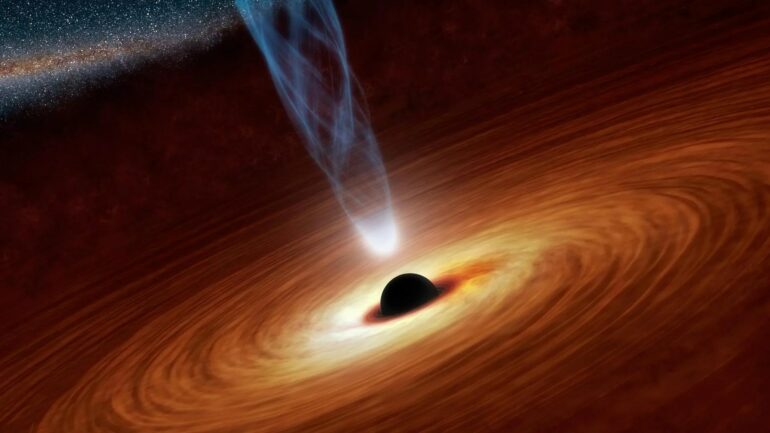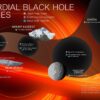An international team of astrophysicists with the participation of the University of Zurich proposes a novel method to detect pairs of the biggest black holes found at the centers of galaxies by analyzing gravitational waves generated by binaries of nearby small stellar black holes. The research is published in the journal Nature Astronomy.
The origin of supermassive black holes found at the centers of galaxies, is still one of the biggest mysteries in astronomy. They may have always been massive and formed when the universe was still very young. Alternatively, they may have grown over time by accreting matter and other black holes. When a supermassive black hole is about to eat another massive black hole, this will emit gravitational waves, which are ripples in spacetime that propagate through the universe.
The challenge of detecting massive black holes
Gravitational waves have recently been detected, but only from small black holes which are the remnants of stars. Detecting the signals of individual pairs of big black holes is still impossible, because present-day detectors are not sensitive to the very low gravitational-wave frequencies they emit. Planned future detectors, such as the space-based ESA-led mission LISA, will partially remedy this, but detecting the most massive black hole pairs will still be out of question.
Use high frequencies to measure lower frequencies
An international team of astrophysicists led by former students at the university of Zurich proposes a new idea, and a novel method, to detect pairs of the biggest black holes found at the centers of galaxies by analyzing gravitational waves generated by binaries of nearby small stellar black holes, which are the remnants of collapsed stars.
This approach, which will require a deci-Hz gravitational-wave detector, would allow the discovery of the biggest supermassive black hole binaries, which might remain inaccessible otherwise.
“Our idea basically works like listening to a radio channel. We propose using the signal from pairs of small black holes similar to how radio waves carry the signal. The supermassive black holes are the music that is encoded in the frequency modulation (FM) of the detected signal,” said Jakob Stegmann, lead author of the study who started this work at the university of Zurich as a visiting student and since then moved to the Max Planck Institute for Astrophysics as a postdoctoral research fellow.
“The novel aspect of this idea is to utilize high frequencies that are easy to detect to probe lower frequencies that we are not sensitive to yet.”
A beacon indicates larger black holes
Recent results from pulsar timing arrays already support the existence of merging supermassive black hole binaries. This evidence is, however, indirect and comes from the collective signal of many distant binaries that effectively create background noise.
The proposed method to detect individual supermassive black hole binaries leverages the subtle changes they cause in the gravitational waves emitted by a pair of nearby small stellar-mass black holes. The small black hole binary thus effectively works as a beacon revealing the existence of the bigger black holes.
By detecting the tiny modulations in signals from small black hole binaries, scientists could thus identify previously hidden supermassive black hole binaries with masses ranging from 10 million to 100 million times that of our sun, even at vast distances.
Lucio Mayer, who is a co-author of the study and black hole theorist at the university of Zurich, added, “As the path for the Laser Interferometer Space Antenna (LISA) is now set, after adoption by ESA last January, the community needs to evaluate the best strategy for the following generation of gravitational wave detectors, in particular which frequency range they should target—studies like this bring a strong motivation to prioritize a deci-Hz detector design.”
More information:
Jakob Stegmann et al, Imprints of massive black-hole binaries on neighbouring decihertz gravitational-wave sources, Nature Astronomy (2024). DOI: 10.1038/s41550-024-02338-0
Provided by
University of Zurich
Citation:
Using small black holes to detect big black holes (2024, August 5)



